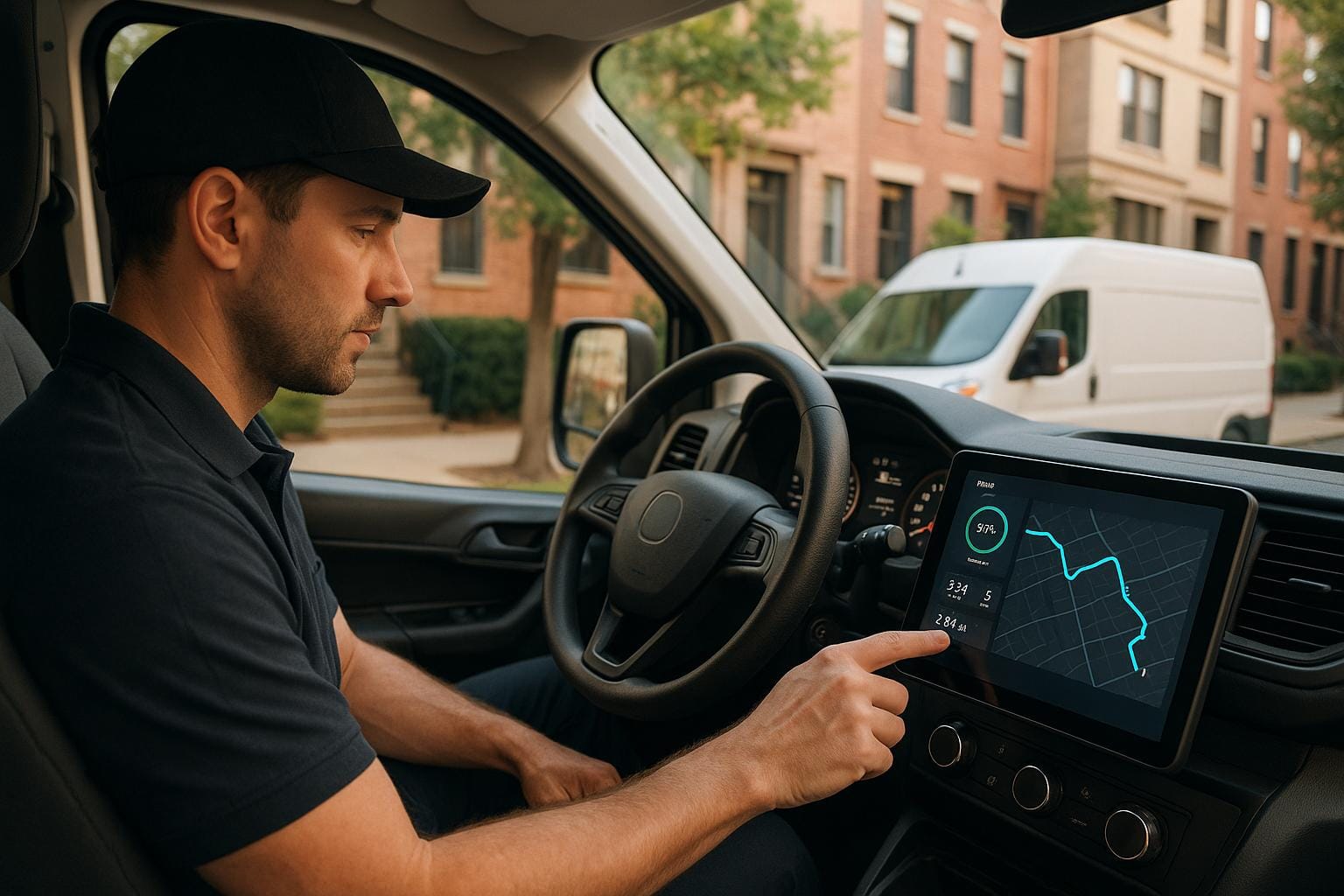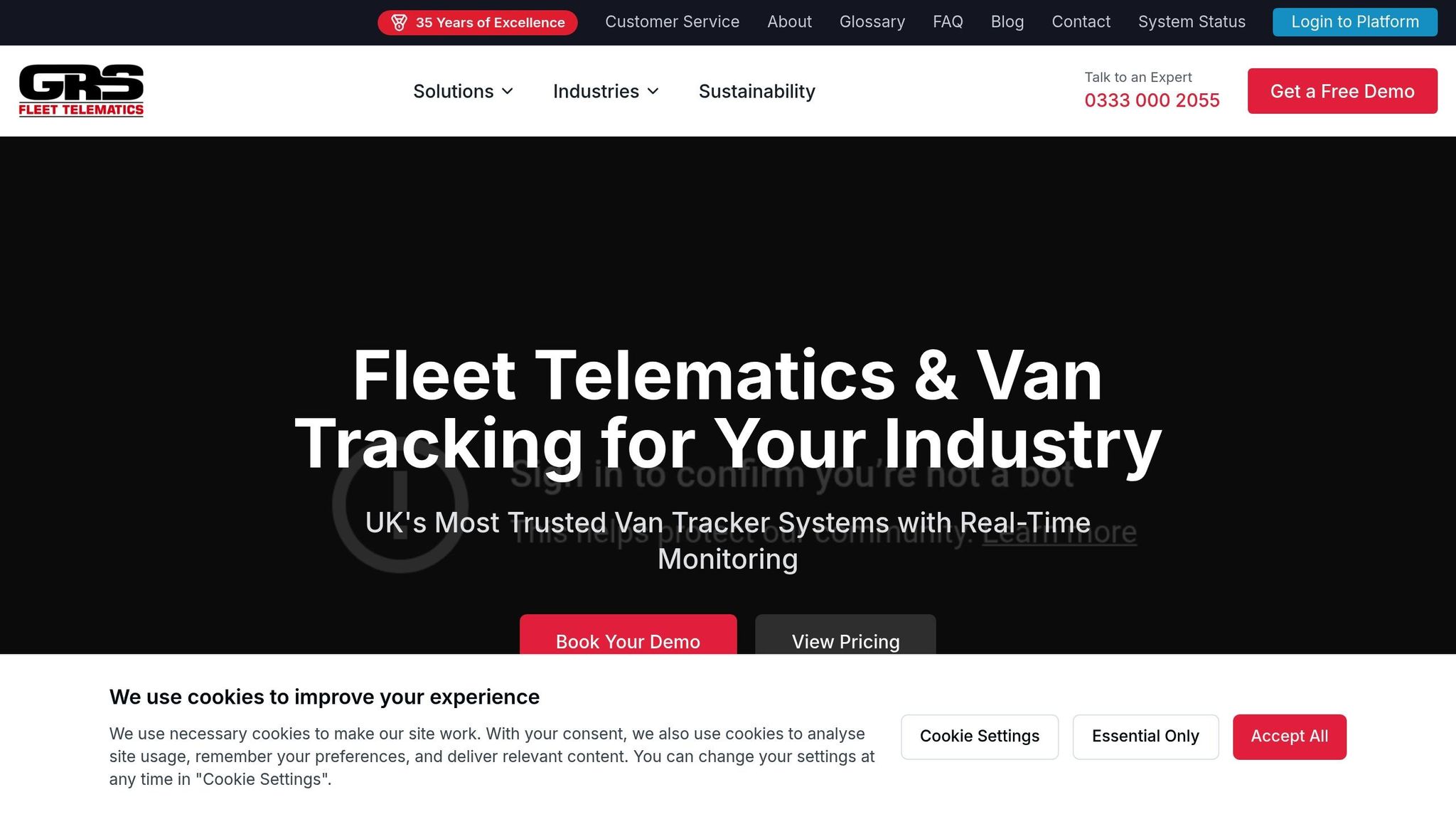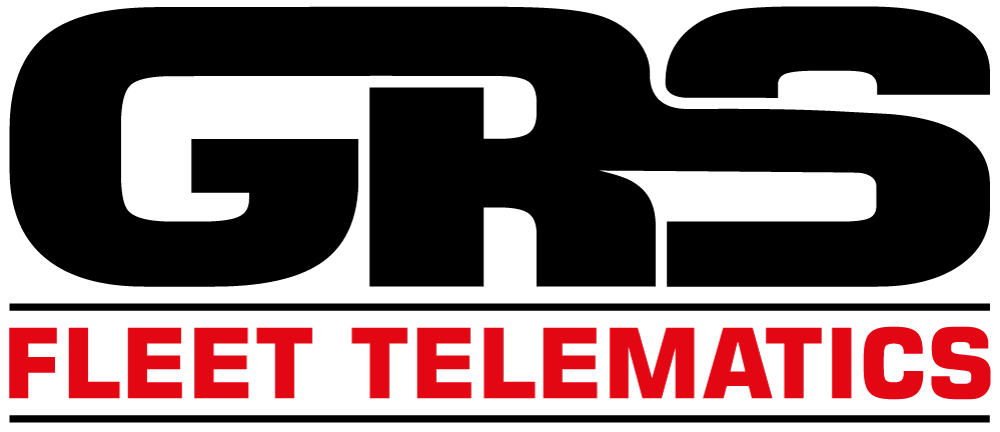Telematics for Last-Mile Idle Time Reduction
Learn how telematics can effectively reduce idle time in last-mile delivery, enhancing efficiency, cutting costs, and supporting environmental goals.

Reducing idle time in last-mile delivery isn't just about saving fuel - it's about cutting costs, improving delivery efficiency, and meeting emissions standards. Telematics systems provide fleet managers with real-time data to monitor vehicle activity, track driver behaviour, and optimise routes.
Key Takeaways:
- Idle Time Challenges: Traffic congestion, poor route planning, and driver habits are major contributors.
- Cost & Environmental Impact: Excessive idling increases fuel costs, maintenance expenses, and carbon emissions, affecting UK Clean Air Zone compliance.
- Telematics Solutions:
- Real-time tracking and engine status reporting.
- Alerts for unnecessary idling and driver behaviour monitoring.
- Tools like geofencing, predictive analytics, and route optimisation.
- Benefits: Reduced fuel consumption, lower emissions, and improved delivery reliability.
Telematics turns data into actionable insights, helping fleets save money and operate more efficiently, while supporting sustainability goals. Systems like GRS Fleet Telematics offer tailored tools starting at £7.99/month per vehicle, making them a practical choice for UK businesses.
Can GPS Vehicle Tracking Be Used To Monitor Idling Time? - Talking Tech Trends
How Telematics Cuts Idle Time in Last-Mile Delivery
Telematics technology is changing the game for fleet managers by offering real-time insights into vehicle activity. Instead of relying on guesswork or driver reports, telematics systems provide accurate data on when and why vehicles are idling. This constant monitoring helps identify areas where improvements can be made.
One of the key strengths of telematics is its ability to spot idle patterns automatically. If a delivery van idles for too long, the system flags it immediately, allowing managers to investigate. Whether the cause is an unauthorised break or unexpected traffic, telematics provides the clarity needed to address these situations effectively.
Modern systems also allow for quick action. Instead of waiting weeks to notice idle issues through fuel bills or customer complaints, managers get instant alerts when vehicles exceed set idle limits. This means they can step in before minor inefficiencies turn into costly problems.
Key Telematics Features for Managing Idle Time
At the heart of idle time management is real-time tracking. GPS-enabled devices monitor vehicle locations and movements continuously, giving managers live updates. If a vehicle stops but the engine keeps running, the system tracks the idle duration and logs it for future analysis.
Another essential feature is engine status reporting, which provides detailed insights into how vehicles are being used. These systems can differentiate between necessary stops, such as loading or customer interactions, and unnecessary idling. Advanced telematics even identifies whether the vehicle is stuck in traffic or simply parked with the engine running, offering valuable context.
Driver behaviour monitoring adds another layer of insight. Telematics can track habits like extended warm-ups, long stops between deliveries, or unnecessary engine use during breaks. This data highlights which drivers might benefit from training to reduce idling.
Custom idle thresholds can be set (e.g., over five minutes) to send instant alerts via email or mobile apps. These alerts help managers communicate with drivers in real time to address the issue immediately.
Geofencing is another useful tool. By setting virtual boundaries around specific locations, such as depots or customer sites, the system can adjust idle monitoring rules to account for legitimate operations while still keeping unnecessary idling in check.
Together, these features provide the foundation for smarter, data-driven strategies to tackle idle time effectively.
Using Data to Improve Idle Time Management
Telematics doesn’t just stop at real-time tracking - it turns data into actionable insights. Analysing historical idle data can reveal patterns, such as areas or times of day where vehicles frequently idle. With this information, fleet managers can make informed decisions, like adjusting delivery schedules to avoid peak traffic or rerouting around congestion hotspots.
Predictive analytics take it a step further by anticipating potential idle time issues. By examining traffic trends, weather forecasts, and past delivery data, telematics can suggest alternative routes or schedules to avoid delays before they occur.
Performance benchmarking is another powerful tool. Comparing idle time metrics across drivers, routes, or time periods highlights best practices and pinpoints areas needing improvement. This takes the guesswork out of optimising fleet performance.
Route optimisation algorithms use real-time traffic data and historical idle records to create more efficient delivery paths. These systems factor in congestion patterns, customer availability, and vehicle capacity to reduce unnecessary stops and minimise idle time.
Telematics also connects idle time to fuel costs, making it easier for managers to prioritise changes based on potential savings. By showing the financial impact of excessive idling, the technology helps build a strong case for action.
These insights not only help reduce idle time but also support compliance with UK emissions standards.
Meeting UK Emissions Standards
Cutting idle time doesn’t just save money - it’s also a step towards meeting environmental requirements. Telematics plays a vital role in helping fleets comply with Clean Air Zone regulations in cities across the UK. By reducing idle time, businesses can lower their vehicle emissions and meet stricter standards.
Many telematics systems include emissions reporting tools, which calculate the environmental impact of idle time. These reports are useful for sustainability initiatives and compliance documentation, especially when applying for permits or exemptions in restricted zones.
Driver coaching programmes, backed by telematics data, can educate drivers on the environmental and financial costs of idling. When drivers understand how their habits affect emissions, they’re more likely to adopt fuel-efficient practices.
As fleets increasingly adopt electric vehicles, telematics becomes even more valuable. These systems can monitor battery usage during idle periods, ensuring optimised charging schedules and maximising vehicle range - critical for maintaining efficiency with electric vans.
Telematics also supports broader carbon reduction goals by tracking emissions saved through idle time management. This data helps businesses demonstrate progress towards sustainability targets, showing customers and stakeholders their commitment to greener operations.
Step-by-Step Guide to Setting Up Telematics
After identifying issues with idle time, this guide walks you through setting up a telematics system to effectively reduce those inefficiencies. Start with basic features and gradually incorporate advanced tools. Most businesses notice improvements within weeks of installation.
The first step is to evaluate your current operations. Take a close look at how your fleet operates before choosing and configuring a telematics system that fits your needs.
Picking the Right Telematics System
Selecting the right telematics system depends on your fleet's size and specific requirements. For smaller fleets (fewer than 10 vehicles), plug-and-play devices are often sufficient. Larger fleets, however, benefit from hardwired systems with more advanced reporting features.
Hardware durability is vital, especially in the UK's challenging weather. Look for devices with an IP67 or higher waterproof rating to ensure they can handle rain and moisture. Battery backup is another key feature, keeping the system running even if the main power supply is interrupted.
Installation options vary. Some systems require professional installation, which can cost between £50 and £150 per vehicle, ensuring everything is set up for optimal performance. Others offer self-installation, which is cheaper but may come with limitations in functionality.
Data connectivity is another important factor. While 4G systems provide faster updates, they come with higher monthly costs. Avoid 3G systems, as these networks are being phased out in the UK. Some systems offer dual connectivity, switching between networks to improve coverage.
Scalability is crucial if your business is growing. Opt for systems that allow you to add vehicles without needing additional hardware or software. Look for pricing models that charge per vehicle with no long-term commitments.
Integration capabilities can save time and effort by syncing with your current route planning or customer management systems. This eliminates duplicate data entry and gives you a clearer view of your operations.
Setting Up Alerts and Monitoring Tools
Once your system is installed, configure alerts to minimise unnecessary engine idling without overwhelming yourself with notifications. Start with basic idle time alerts that trigger after five minutes of idling.
Idle time thresholds should align with your operations. Urban routes may require more lenient thresholds due to traffic and loading zones, while rural routes can have stricter limits. Tailor thresholds to different route types to avoid false alarms.
Geofencing rules are useful for adjusting alert settings based on location. For instance, you might relax idle time limits at customer sites but enforce stricter rules at service stations or depots.
Alert delivery methods can be customised based on urgency. Use email for non-critical updates, SMS for immediate issues, or dashboard notifications for centralised monitoring.
Escalation procedures ensure action is taken if drivers don’t respond to alerts. For example, if an alert goes unanswered, it can be escalated to a supervisor to address the issue before it escalates further.
Driver communication tools allow you to send direct messages to vehicles. Quick reminders like "Please switch off the engine during loading" can resolve issues in real time.
Reporting schedules help you track progress without overwhelming your team. Daily summaries can highlight total idle time and any improvements, making it easier to stay on top of trends.
Using Telematics for Better Route Planning
With alerts in place, you can use telematics data to improve route planning. Real-time traffic updates combined with historical data help identify more efficient routes, often cutting idle time by 15-25% in the first month.
Traffic pattern analysis and dynamic routing leverage historical data to pinpoint congestion hotspots. For example, if vehicles frequently idle on the A40 between 8-9 AM, you can adjust departure times or reroute to avoid delays.
Customer availability patterns become clearer over time, allowing you to plan around clients who typically cause delays. This might involve scheduling extra time or setting specific delivery windows.
Delivery time optimisation uses actual performance data to fine-tune schedules. If deliveries consistently take 15 minutes instead of the expected 10, routes can be adjusted to reflect this, avoiding unrealistic timelines.
Load planning integration ensures vehicle capacity is considered alongside route efficiency. Telematics data can help redistribute loads, reducing the need for multiple trips on certain routes.
Performance feedback loops allow for continuous improvement. By analysing planned versus actual routes on a weekly basis, you can refine your operations and boost efficiency.
To ensure a smooth rollout, introduce these features gradually. Most businesses take 2-4 weeks to move from installation to full optimisation, allowing time to fine-tune the system for maximum impact.
Key Features of GRS Fleet Telematics

GRS Fleet Telematics offers tools to cut idle time and enhance fleet security, making it a reliable choice for last-mile delivery operations. Its features are specifically designed to address inefficiencies and safeguard vehicles.
Dual-Tracker Technology for Round-the-Clock Monitoring
GRS Fleet Telematics employs dual-tracker technology, combining a primary device with a Bluetooth backup. This setup ensures continuous tracking of key vehicle data like engine status, location, and activity. With this real-time information, fleet managers can quickly identify issues and adjust routes for maximum efficiency.
Driver Metrics and Geofencing Alerts
The system tracks driver behaviour, including acceleration, braking, and idling habits. Geofencing adds another layer of control by setting specific zones that trigger alerts or adjust idle thresholds. Speed monitoring and eco-driving analytics are also included, offering actionable insights for targeted driver training and reducing unnecessary idle time.
Remote Control and Recovery Support
The Ultimate package (£99) takes security to the next level with remote immobilisation, allowing managers to disable vehicles in unauthorised areas. It also provides 24/7 recovery support, boasting an impressive 91% recovery rate. Fuel consumption alerts help tackle excessive idling, while white-label branding enables seamless tracking integration with customer delivery updates.
Pricing starts at £7.99 per vehicle per month for the software subscription. Hardware options include the Essential single tracker (£35) and the Ultimate dual-tracker with immobilisation (£99), making the system a cost-effective choice for fleets of any size.
Tracking and Maintaining Idle Time Improvements
Cutting down on idle time isn’t a one-and-done task - it requires consistent tracking and adjustments. Telematics data plays a key role in shaping strategies that lead to lasting progress. Here’s how you can keep those improvements on track.
Monitoring Key Performance Indicators (KPIs)
Fleet analytics offer a clear picture of essential metrics like fuel consumption, maintenance expenses, and overall vehicle performance. By conducting regular reviews and using real-time GPS tracking, you can spot patterns and identify where idling remains an issue.
Driver Training and Feedback Methods
Telematics data doesn’t just highlight problems - it also provides actionable insights. By analysing driver behaviours and eco-driving patterns, you can pinpoint habits that waste fuel. Use this information to deliver focused training sessions aimed at minimising unnecessary idling.
Regular System Reviews and Updates
Keeping idle time in check means staying vigilant. Regularly reviewing telematics data can uncover issues like driver fatigue or scheduling inefficiencies. These ongoing evaluations ensure your fleet remains aligned with broader efficiency goals.
Conclusion: Improving Efficiency with Telematics
Telematics is transforming last-mile delivery by addressing one of the biggest inefficiencies: idle time. With real-time data and monitoring, fleet managers gain a clear view of their operations, allowing for actionable improvements that not only enhance efficiency but also reduce environmental impact. These insights pave the way for smarter, more sustainable fleet management.
Key Takeaways for Fleet Managers
Reducing idle time effectively comes down to leveraging tools like real-time tracking, geofencing, and integrated route planning. Telematics systems play a central role by monitoring vehicle activity, pinpointing inefficiencies, and providing data that drives meaningful changes. For example, route optimisation becomes more accurate when you can identify exactly where delays are happening. Similarly, monitoring driver behaviour helps tackle unnecessary idling before it turns into a costly habit.
Another advantage is the seamless integration of telematics data with route planning systems. This ensures delivery schedules take real-world factors like traffic and customer availability into account, significantly cutting down waiting times. By aligning these insights with driver feedback, fleet managers can unlock consistent and sustainable cost savings.
However, success doesn’t happen overnight. Reducing idle time requires an ongoing commitment. Regular analysis of telematics data, combined with focused driver training and system updates, ensures that improvements are maintained and continue to deliver benefits month after month.
GRS Fleet Telematics: A Trusted Partner

For fleet managers ready to take the next step, GRS Fleet Telematics offers the tools needed to make a real difference. With dual-tracker technology and pricing starting at just £7.99 per month, the system provides professional-grade fleet management without breaking the bank.
Key features include real-time tracking and driver behaviour monitoring, giving managers the insights they need to address idle time issues swiftly. Geofencing capabilities and 24/7 recovery support, boasting an impressive 91% recovery rate, ensure complete visibility and security for last-mile operations.
For businesses across the UK looking to cut operational costs and enhance delivery performance, GRS Fleet Telematics offers a proven solution to reduce idle time and drive efficiency.
FAQs
How does telematics help reduce idle time in last-mile delivery operations?
Telematics plays a key role in cutting down idle time during last-mile delivery. By leveraging real-time tracking and advanced data analysis, it helps map out the most efficient routes and improves dispatching decisions. This means delivery vehicles can steer clear of unnecessary delays, detours, or traffic snags, keeping things moving smoothly.
What’s more, telematics systems keep an eye on both driver behaviour and vehicle performance. They flag issues like excessive idling or inefficient driving habits, enabling businesses to address these problems early on. The result? Faster deliveries and a boost in overall operational efficiency.
What telematics features help businesses comply with UK Clean Air Zone regulations?
Telematics systems bring a range of tools to help businesses navigate the UK Clean Air Zone regulations effectively. Key features include GPS tracking, which provides real-time updates on vehicle locations and geofencing alerts to steer clear of restricted zones. Another critical tool is emission monitoring, allowing businesses to keep an eye on vehicle pollutants and ensure they meet required standards. Plus, driver behaviour analysis helps encourage eco-friendly and fuel-efficient driving habits.
On top of that, telematics platforms offer compliance reporting tools. These make it simpler for businesses to monitor and document their adherence to Clean Air Zone requirements. By using these systems, companies can not only stay compliant but also work towards greener and more efficient fleet management.
How can businesses use telematics to optimise routes and reduce vehicle idling?
Businesses can make their operations more efficient by using telematics systems equipped with real-time GPS tracking and route optimisation tools. These tools allow companies to monitor vehicle locations and traffic conditions, enabling on-the-go route adjustments to dodge congestion and cut down on idle time. The result? Lower fuel consumption and reduced emissions.
Telematics also offers insights into driver behaviour, highlighting habits like excessive idling or aggressive driving. With this data, businesses can provide tailored training to drivers, improving efficiency even further. By regularly analysing telematics reports and adjusting routes based on traffic trends, companies can achieve ongoing improvements, save costs, and ensure smoother day-to-day operations.
